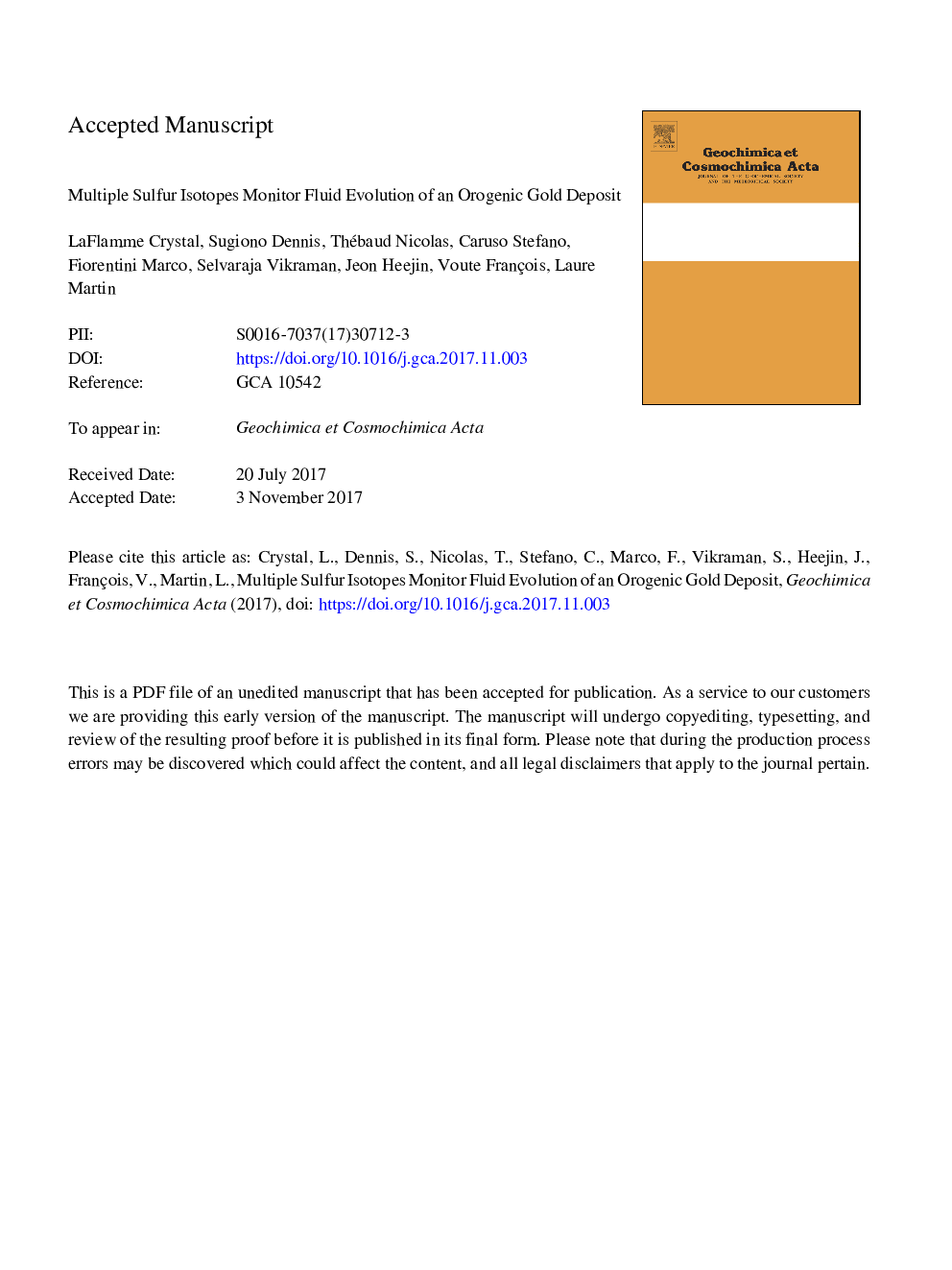| کد مقاله | کد نشریه | سال انتشار | مقاله انگلیسی | نسخه تمام متن |
|---|---|---|---|---|
| 8910959 | 1637935 | 2018 | 29 صفحه PDF | دانلود رایگان |
عنوان انگلیسی مقاله ISI
Multiple sulfur isotopes monitor fluid evolution of an Archean orogenic gold deposit
ترجمه فارسی عنوان
ایزوتوپ های چندگانه گوگرد، تکامل مایع رسوب طلای اورژانسی آرچای را کنترل می کنند
دانلود مقاله + سفارش ترجمه
دانلود مقاله ISI انگلیسی
رایگان برای ایرانیان
کلمات کلیدی
موضوعات مرتبط
مهندسی و علوم پایه
علوم زمین و سیارات
ژئوشیمی و پترولوژی
چکیده انگلیسی
The evolution of a gold-bearing hydrothermal fluid from its source to the locus of gold deposition is complex as it experiences rapid changes in thermochemical conditions during ascent through the crust. Although it is well established that orogenic gold deposits are generated during time periods of abundant crustal growth and/or reworking, the source of fluid and the thermochemical processes that control gold precipitation remain poorly understood. In situ analyses of multiple sulfur isotopes offer a new window into the relationship between source reservoirs of Au-bearing fluids and the thermochemical processes that occur along their pathway to the final site of mineralisation. Whereas δ34S is able to track changes in the evolution of the thermodynamic conditions of ore-forming fluids, Î33S is virtually indelible and can uniquely fingerprint an Archean sedimentary reservoir that has undergone mass independent fractionation of sulfur (MIF-S). We combine these two tracers (δ34S and Î33S) to characterise a gold-bearing laminated quartz breccia ore zone and its sulfide-bearing alteration halo in the (+6 Moz Au) structurally-controlled Archean Waroonga deposit located in the Eastern Goldfields Superterrane of the Yilgarn Craton, Western Australia. Over 250 analyses of gold-associated sulfides yield a δ34S shift from what is interpreted as an early pre-mineralisation phase, with chalcopyrite-pyrrhotite (δ34Sâ¯=â¯+0.7â° to +2.9â°) and arsenopyrite cores (δ34Sâ¯=â¯â¼â0.5â°), to a syn-mineralisation stage, reflected in Au-bearing arsenopyrite rims (δ34Sâ¯=â¯â7.6â° to +1.5â°). This shift coincides with an unchanging Î33S value (Î33Sâ¯=â¯+0.3â°), both temporally throughout the Au-hosting hydrothermal sulfide paragenesis and spatially across the Au ore zone. These results indicate that sulfur is at least partially recycled from MIF-S-bearing Archean sediments. Further, the invariant nature of the observed MIF-S signature demonstrates that sulfur is derived from a homogeneous MIF-S-bearing fluid reservoir at depth, rather than being locally sourced at the site of Au precipitation. Finally, by constraining the MIF-S-bearing sulfur source to a fixed reservoir, we are able to display the thermochemical evolution of the ore fluid in δ34S space and capture the abrupt change in oxidation state that causes Au precipitation. Our results highlight the importance of constraining multiple sulfur isotopes in space and time in order to elucidate the source and evolution of any given Au-bearing fluid.
ناشر
Database: Elsevier - ScienceDirect (ساینس دایرکت)
Journal: Geochimica et Cosmochimica Acta - Volume 222, 1 February 2018, Pages 436-446
Journal: Geochimica et Cosmochimica Acta - Volume 222, 1 February 2018, Pages 436-446
نویسندگان
Crystal LaFlamme, Dennis Sugiono, Nicolas Thébaud, Stefano Caruso, Marco Fiorentini, Vikraman Selvaraja, Heejin Jeon, François Voute, Laure Martin,
